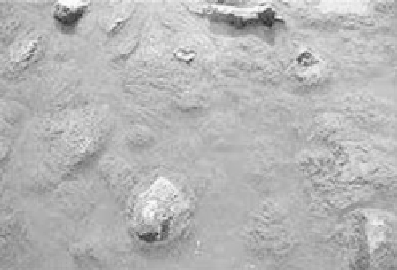Environmental Engineering Reference
In-Depth Information
FIGURE 31.1
Harmful phosphor bloom.
recreational use is staggering in some locations. It is occurring in all categories of water:
rivers, streams, lakes, reservoirs, estuaries, and coastal areas, often resulting in “eutrophic”
or oxygen-deprived water. The amount of nutrients entering our waters has dramatically
escalated during the past 50 years. A 2006 US Environmental Protection Agency report
identiies approximately 207,355 miles of streams (~30%) that had “high” concentrations of
phosphorus, while 108,029 miles of streams had “medium” concentrations. Harmful algae
blooms nationally cause 78% of continental coastal areas to exhibit symptoms of eutro-
phication. Runoff from agricultural sources contributed an estimated 84% of the nonpoint
source phosphate loading to surface water in the United States (Zaimes and Schultz, 2002).
This results in an estimated annual $2.2 billion economic impact (Krögera et al., 2012).
Yet phosphorus is a scarce resource. Some global estimates of easy-to-obtain phosphorus
reserves are just 35 years (Clabby, 2010). Morocco, Jordan, South Africa, the United States, and
China account for 90% of the reserves (Zaimes and Schultz, 2002). The use of phosphorus has
doubled since 1960, and this trend will increase as world food requirements are expected
to double by 2030 (US Department of Agriculture). Conservation technologies must not
only protect us from phosphorus but must also serve to recover this valuable resource.
Phosphorus, the 13th element, is part of all life and circulates through the environment as
both inorganic and organic compounds and in soluble and particulate forms. The primary
source for phosphorus is “phosphate rock,” which contains ~10% phosphorus. The rock is
mined and phosphorus extracted by chemical methods to form phosphoric acid, which is
used for fertilizer, food, and industrial products. In agriculture, crops remove phosphorus
from soils, which then need to be replenished or over time it limits crop growth. Crops
are used to produce animal protein but a signiicant amount passes through and is found
in animal waste. Municipal wastewater also contains phosphorus, albeit at tremendously
lower concentrations, that originates from human excretion and common household
products. International efforts exist to economically capture and recycle this phosphorus.
While still in its infancy, someday one might imagine that the phosphate we consume as
food will return back to food production and in the many products that require a phos-
phate input. Phosphorus is banned in many states for some products.
Sources of phosphate water pollution can be divided into two broad categories: point
and nonpoint sources. Point sources are generally sources from industry or wastewater
treatment systems that enter bodies of water from a discharge pipe or point. Nonpoint
sources of water pollution result when rainfall/storm water carries or collects pollutants
across large surface areas, paved or nonpaved, eventually lowing into surface water, a

